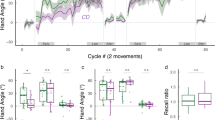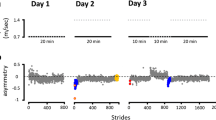Abstract
Sensorimotor adaptation tasks can be classified into two types. When subjects adapt movements to visual feedback perturbations such as in prism lens adaptation, they perform kinematic adaptations. When subjects adapt movements to force field perturbations such as with robotic manipulanda, they perform kinetic adaptations. Neuroimaging studies have shown basal ganglia involvement in kinetic adaptations, but have found little evidence of basal ganglia involvement in kinematic adaptations, despite reports of deficits in patients with diseases of the basal ganglia, such as Parkinson’s and Huntington’s disease, in these. In an effort to resolve such apparent discrepancy, we used FMRI to focus on the first few minutes of practice during kinematic adaptation. Human subjects adapted to visuomotor rotations in the context of a joystick aiming task while lying supine in a 3.0 T MRI scanner. As demonstrated previously, early adaptive processes were associated with BOLD activation in the cerebellum and the sensory and motor cortical regions. A novel finding of this study was bilateral basal ganglia activation. This suggests that, at least for early learning, the neural correlates of kinematic adaptation parallel those of other types of skill learning. We observed activation in the right globus pallidus and putamen, along with the right prefrontal, premotor and parietal cortex, which may support spatial cognitive processes of adaptation. We also observed activation in the left globus pallidus and caudate nucleus, along with the left premotor and supplementary motor cortex, which may support the sensorimotor processes of adaptation. These results are the first to demonstrate a clear involvement of basal ganglia activation in this type of kinematic motor adaptation.






Similar content being viewed by others
References
Bock O (1992) Adaptation of aimed arm movements to sensorimotor discordance: evidence for direction-independent gain control. Behav Brain Res 51:41–50
Bock O, Abeele S, Eversheim U (2003) Human adaptation to rotated vision: interplay of a continuous and a discrete process. Exp Brain Res 152:528–532
Bock O, Burghoff M (1997) Visuo-motor adaptation: evidence for a distributed amplitude control system. Behav Brain Res 89:267–273
Boulet C, Lemay M, Bedard MA, Chouinard MJ, Chouinard S, Richer F (2005) Early Huntington’s disease affects movements in transformed sensorimotor mappings. Brain Cogn 57:236–243
Brown LL, Schneider JS, Lidsky TI (1997) Sensory and cognitive functions of the basal ganglia. Curr Opin Neurobiol 7:157–163
Canavan AGM, Passingham RE, Marsden CE, Quinn N, Wyke M, Polkey CE (1990) Prism adaptation and other tasks involving spatial abilities in patients with Parkinson’s disease, patients with frontal lobe lesions, and patients with unilateral temporal lobectomies. Neuropsychologia 28:969–984
Clower DM, Hoffman JM, Votaw JR, Faber TL, Woods RP, Alexander GE (1996) Role of posterior parietal cortex in the recalibration of visually guided reaching. Nature 383:618–621
Contreras-Vidal JL, Buch ER (2003) Effects of Parkinson’s disease on visuomotor adaptation. Exp Brain Res 150:25–32
Cunningham HA, Welch RB (1994) Multiple concurrent visual-motor mappings: implications for models of adaptation. J Exp Psychol Hum Percept Perform 20:987–999
Doyon J, Benali H (2005) Reorganization and plasticity in the adult brain during learning of motor skills. Curr Opin Neurobiol 15:161–167
Doyon J, Penhune V, Ungerleider LG (2003) Distinct contribution of the cortico-striatal and cortico-cerebellar systems to motor skill learning. Neuropsychologia 41:252–262
Dum RP, Strick PL (2002) Motor areas in the frontal lobe of the primate. Physiol Behav 77:677–682
Eliassen JC, Souza T, Sanes JN (2001) Human brain activation accompanying explicitly directed movement sequence learning. Exp Brain Res 141:269–280
Evans AC, Kamber M, Collins DL, Macdonald D (1994) An MRI-based probabilistic atlas of neuroanatomy. In: Shorvon S, Fish D, Andermann F, Bydder GM, Stefan H (eds) Magnetic resonance scanning and epilepsy. NATO ASI Series A, Life Sciences, vol 264. Plenum Press, New York, pp263–274
Eversheim U, Bock O (2001) Evidence for processing stages in skill acquisition: a dual-task study. Learn Mem 8:183–189
Friedman HR, Goldman-Rakic PS (1994) Coactivation of prefrontal cortex and inferior parietal cortex in working memory tasks revealed by 2DG functional mapping in the rhesus monkey. J Neurosci 14:2775–2788
Friston KJ, Holmes AP, Worsely K, Poline J, Frith CD, Frackowiak RS (1995) Statistical parametric maps in functional imaging: a general linear approach. Hum Brain Mapp 2:189–210
Ghahramani Z, Wolpert DM (1997) Modular decomposition in visuomotor learning. Nature 386:392–395
Ghilardi M, Ghez C, Dhawan V, Moeller J, Mentis M, Nakamura T, Antonini A, Eidelberg D (2000) Patterns of regional brain activation associated with different forms of motor learning. Brain Res 871:127–145
Grafton ST, Hazeltine E, Ivry RB (1998) Abstract and effector-specific representations of motor sequences identified with PET. J Neurosci 18:9420–9428
Grefkes C, Ritzl A, Zilles K, Fink GR (2004) Human medial intraparietal cortex subserves visuomotor coordinate transformation. Neuroimage 23:1494–1506
Hoover JE, Strick PL (1993) Multiple output channels in the basal ganglia. Science 259:819–821
Huynh H, Feldt LS (1970) Conditions under which the mean square ratios in repeated measures designs have exact F-distributions. J Am Stat Assoc 65:1582–1589
Imamizu H, Miyauchi S, Tamada T, Sasaki Y, Takino R, Putz B, Yoshioka T, Kawato M (2000) Human cerebellar activity reflecting an acquired internal model of a new tool. Nature 403:192–195
Inoue K, Kawashima R, Satoh K, Kinomura S, Goto R, Sugiura M, Ito M, Fukuda H (1997) Activity in the parietal area during visuomotor learning with optical rotation. Neuroreport 18:3979–3983
Inoue K, Kawashima R, Satoh K, Kinomura S, Sugiura M, Goto R, Ito M, Fukuda H (2000) A PET study of visuomotor learning under optical rotation. Neuroimage 11:505–516
Jonides J, Smith EE, Koeppe RA, Awh E, Minoshima S, Mintun MA (1993) Spatial working memory in humans as revealed by PET. Nature 363:623–625
Kelly RM, Strick PL (2004) Macro-architecture of basal ganglia loops with the cerebral cortex: use of rabies virus to reveal multisynaptic circuits. Prog Brain Res 143:449–459
Krakauer JW, Ghilardi MF, Mentis M, Barnes A, Veytsman M, Eidelberg D, Ghez C (2004) Differential cortical and subcortical activations in learning rotations and gains for reaching: a PET study. J Neurophysiol 91:924–933
Krakauer JW, Pine ZM, Ghilardi MF, Ghez C (2000) Learning of visuomotor transformations for vectorial planning of reaching trajectories. J Neurosci 20:8916–8924
Krebs HI, Brashers-Krug T, Rauch SL, Savage CR, Hogan N, Rubin RH, Fischman AJ, Alpert NM (1998) Robot-aided functional imaging: application to a motor learning study. Hum Brain Mapp 6:59–72
Laforce R Jr, Doyon J (2002) Differential role for the striatum and cerebellum in response to novel movements using a motor learning paradigm. Neuropsychologia 40:512–517
McKiernan KA, Kaufman JN, Kucera-Thompson J, Binder JR (2003) A parametric manipulation of factors affecting task-induced deactivation in functional neuroimaging. J Cogn Neurosci 15:394–408
Middleton FA, Strick PL (2000) Basal ganglia output and cognition: evidence from anatomical, behavioral, and clinical studies. Brain Cogn 42:183–200
Middleton FA, Strick PL (2002) Basal-ganglia ‘projections’ to the prefrontal cortex of the primate. Cereb Cortex 12:926–935
Nakahara H, Doya K, Hikosaka O (2001) Parallel cortico-basal ganglia mechanisms for acquisition and execution of visuomotor sequences—a computational approach. J Cogn Neurosci 13:626–647
Noll DC, Cohen JD, Meyer CH, Schneider W (1995) Spiral K-space MR imaging of cortical acitvation. J Magn Reson Imaging 5:49–56
Ojakangas CL, Ebner TJ (1992) Purkinje cell complex and simple spike changes during a voluntary arm movement learning task in the monkey. J Neurophysiol 68:2222–2236
Picard N, Strick PL (1996) Motor areas of the medial wall: a review of their location and functional activation. Cereb Cortex 6:342–353
Picard N, Strick PL (2001) Imaging the premotor areas. Curr Opin Neurobiol 11:663–672
Pine ZM, Krakauer JW, Gordon J, Ghez C (1996) Learning of scaling factors and reference axes for reaching movements. Neuroreport 7:2357–2361
Raichle ME, MacLeod AM, Snyder AZ, Powers WJ, Gusnard DA, Shulman GL (2001) A default mode of brain function. Proc Natl Acad Sci 98:676–682
Richter W, Somorjai R, Summers R, Jarmasz M, Menon RS, Gati JS et al (2000) Motor area activity during mental rotation studied by time-resolved single-trial fMRI. J Cogn Neurosci 12:310–320
Schmahmann JD, Doyon J, Toga A, Evans A, Petrides M (2000) MRI atlas of the human cerebellum. Academic Press, San Diego
Seidler RD, Noll DC, Thiers G (2004) Feedforward and feedback processes in motor control. Neuroimage 22:1775–1783
Seidler RD, Purushotham A, Kim S-G, Ugurbil K, Willingham D, Ashe J (2002) Cerebellum activation associated with performance change but not motor learning. Science 296:2043–2046
Seidler RD, Purushotham A, Kim S, Ugurbil K, Willingham D, Ashe J (2005) Neural correlates of encoding and expression in implicit sequence learning. Exp Brain Res 165:114–124
Shadmehr R, Holcomb HH (1997) Neural correlates of motor memory consolidation. Science 277:821–825
Shadmehr R, Holcomb HH (1999) Inhibitory control of competing motor memories. Exp Brain Res 126:235–251
Shadmehr R, Mussa-Ivaldi FA (1994) Adaptive representation of dynamics during learning of a motor task. J Neurosci 14:3208–3224
Talairach J, Tournoux P (1988) Co-planar stereotaxic atlas of the human brain. 3-dimensional proportional system: an approach to cerebral imaging (translated by Mark Rayport). Thieme, New York
Teasdale N, Bard C, Fleury M, Young D, Proteau L (1993) Determining movement onsets from temporal series. J Mot Behav 25:97–106
Welch RB, Choe CS, Heinrich DR (1974) Evidence for a three-component model of prism adaptation. J Exp Psychol 103:700–705
Winter DA (1990) Biomechanics and motor control of human movement. 2nd edn. Wiley, New York
Woods RP, Grafton ST, Holmes CJ, Cherry SR, Mazziotta JC (1998) Automated image registration I. General methods and intrasubject registration. J Comput Assist Tomogr 22:139–152
Acknowledgments
This work was supported by grants from the UM FMRI Center and the UM Rackham faculty grant program, NIH AG024106, and NIH AG08808 (UM Claude D. Pepper OAIC Research Career Development Core). We thank K. Newnham for his expertise during data collection, and J. Ashe, V. Penhune and C. Ojakangas for providing thoughtful comments on earlier drafts of this manuscript.
Author information
Authors and Affiliations
Corresponding author
Rights and permissions
About this article
Cite this article
Seidler, R.D., Noll, D.C. & Chintalapati, P. Bilateral basal ganglia activation associated with sensorimotor adaptation. Exp Brain Res 175, 544–555 (2006). https://doi.org/10.1007/s00221-006-0571-y
Received:
Accepted:
Published:
Issue Date:
DOI: https://doi.org/10.1007/s00221-006-0571-y




